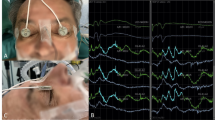Abstract
Purpose
Coronary bypass surgery is emphasized in aetiology of ischemic optic neuropathy. Our aim in this study was to investigate the pattern visual evoked potentials (PVEP) in patients before and after coronary bypass surgery.
Methods
Thirty-one patients were included in the study. After a full ophthalmological evaluation, PVEP was assesed in the pre and postoperative periods. Operative times, hematological parameters, blood pressures, number of transfusions, body temperatures, anaesthetic drugs and systemic illnesses were recorded for each patient.
Results
The mean age of the patients were 59 ± 10.4 years. There was 22 men and 9 women in the study. Only 3 of them needed transfusion during the surgery. The mean duration of the surgery was 3.2 ± 0.7 h. None of the patients had a history of visual disturbance or postoperative ischemic optic neuropathy. The mean VEP P100 amplitude was not statistically significantly different but the mean VEP P100 latency showed statistically significant difference between the preoperative and postoperative periods. (p = 0.014) This significance was more appereant in patients with systemic illnesses. (p = 0.023) There was a positive correlation between the age and VEP P100 latency (r = 0.402, p < 0.05).
Conclusions
Although surgical techniques and equipments are developing each day in the field of cardiopulmonary bypass surgery, the contributing factors such as hypothermia, anemia and diabetes still seem to affect neurophysiological functions even after a noncomplicated surgery.
Similar content being viewed by others
References
Nenekidis I, Pournaras CJ, Tsironi E et al (2012) Vision impairment during cardiac surgery and extracorporeal circulation: current understanding and the need for further investigation. Acta Ophthalmol 90(3):e168–e172. https://doi.org/10.1111/j.1755-3768.2011.02317.x
Blauth CI, Smith PL, Arnold JV et al (1990) Influence of oxygenator type on the prevalence and extent of microembolic retinal ischemia during cardiopulmonary bypass. Assessment by digital image analysis. J Thorac Cardiovasc Surg 99(1):61–69
Holder GE (2004) Electrophysiological assessment of optic nerve disease. Eye (Lond) 18(11):1133–1143. https://doi.org/10.1038/sj.eye.6701573
Mukartihal G, Radhakrishnan S, Ramasubba Reddy M et al (2005) Statistical analysis of visual evoked potentials in optic neuritis and ischemic optic neuropathy subjects. Conf Proc IEEE Eng Med Biol Soc 2005:1193–1195. https://doi.org/10.1109/IEMBS.2005.1616637
Keenan NK, Taylor MJ, Coles JG et al (1987) The use of VEPs for CNS monitoring during continuous cardiopulmonary bypass and circulatory arrest. Electroencephalogr Clin Neurophysiol 68(4):241–246. https://doi.org/10.1016/0168-5597(87)90044-x
Sasaki T, Itakura T, Suzuki K et al (2010) Intraoperative monitoring of visual evoked potential: introduction of a clinically useful method. J Neurosurg 112(2):273–284. https://doi.org/10.3171/2008.9.JNS08451
Tidow-Kebritchi S, Jay WM (2003) Anterior ischemic optic neuropathy following off-pump cardiac bypass surgery. Semin Ophthalmol 18(4):166–168. https://doi.org/10.1080/08820530390895154
Trethowan BA, Gilliland H, Popov AF et al (2011) A case report and brief review of the literature on bilateral retinal infarction following cardiopulmonary bypass for coronary artery bypass grafting. J Cardiothorac Surg 6:154. https://doi.org/10.1186/1749-8090-6-154
Algarín C, Peirano P, Garrido M et al (2003) Iron deficiency anemia in infancy: long-lasting effects on auditory and visual system functioning. Pediatr Res 53(2):217–223. https://doi.org/10.1203/01.PDR.0000047657.23156.55
Hetzler BE, Boyes WK, Creason JP et al (1988) Temperature-dependent changes in visual evoked potentials of rats. Electroencephalogr Clin Neurophysiol 70(2):137–154. https://doi.org/10.1016/0013-4694(88)90114-9
Monga M, Walia V, Gandhi A et al (2010) Effect of iron deficiency anemia on visual evoked potential of growing children. Brain Dev 32(3):213–216. https://doi.org/10.1016/j.braindev.2009.02.009
Connor JR, Menzies SL, Burdo JR et al (2001) Iron and iron management proteins in neurobiology. Pediatr Neurol 25(2):118–129. https://doi.org/10.1016/s0887-8994(01)00303-4
George TJ, Beaty CA, Kilic A et al (2012) Hemoglobin drift after cardiac surgery. Ann Thorac Surg 94(3):703–709. https://doi.org/10.1016/j.athoracsur.2012.03.038
Kalyani SD, Miller NR, Dong LM et al (2004) Incidence of and risk factors for perioperative optic neuropathy after cardiac surgery. Ann Thorac Surg 78(1):34–37. https://doi.org/10.1016/j.athoracsur.2004.02.015
Williams I (2003) Risk factors for ischemic optic neuropathy after cardiopulmonary bypass: a matched case/control study, by GA Nuttall, JA Garrity, JA Dearani, MD Abel, DR Schroeder, and CJ Mullany Anesth Analg 93:1410-6, 2001. Surv Ophthalmol 48(2):237–238. https://doi.org/10.1016/s0039-6257(02)00452-6
Ziegler O, Guerci B, Algan M et al (1994) Improved visual evoked potential latencies in poorly controlled diabetic patients after short-term strict metabolic control. Diabetes Care 17(10):1141–1147. https://doi.org/10.2337/diacare.17.10.1141
Celesia GG, Daly RF (1977) Effects of aging on visual evoked responses. Arch Neurol 34(7):403–407. https://doi.org/10.1001/archneur.1977.00500190037005
Funding
No financial support was received for this submission.
Author information
Authors and Affiliations
Corresponding author
Ethics declarations
Conflict of interest
The authors declare that they have no conflict of interest.
Consent to publish
All participants agreed to the collection and anonymous publication of the data.
Ethical approval
All procedures performed in studies involving human participants were in accordance with the ethical standards of the Tokat Gaziosmanpaşa University Faculty of Medicine clinical research ethics committee (20-KAEK-23) and with the 1964 Helsinki declaration and its later amendments or comparable ethical standards.
Informed consent
Informed consent was obtained from all individual participants included in the study.
Additional information
Publisher's Note
Springer Nature remains neutral with regard to jurisdictional claims in published maps and institutional affiliations.
The Clinical Research Registration number obtained from the clinical research ethics committee of Tokat Gaziosmanpaşa University Faculty of Medicine is 20-KAEK-235.
Rights and permissions
About this article
Cite this article
Güneş, A., Konuk, Ş.G., Demir, H.D. et al. Evaluation of VEP parameters in patients before and after cardiopulmonary by-pass surgery. Int Ophthalmol 43, 397–402 (2023). https://doi.org/10.1007/s10792-022-02435-x
Received:
Accepted:
Published:
Issue Date:
DOI: https://doi.org/10.1007/s10792-022-02435-x




